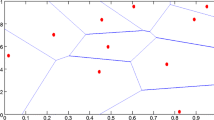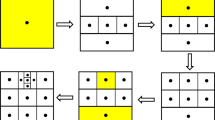Abstract
The metamodel-based high-dimensional model representation (e.g., RBF-HDMR) has recently been proven to be very promising for modeling high dimensional functions. A frequently encountered scenario in practical engineering problems is the need of building accurate models under limited computational budget. In this context, the original RBF-HDMR approach may be intractable due to the independent and successive treatment of the component functions, which translates in a lack of knowledge on when the modeling process will stop and how many points (simulations) it will cost. This article proposes an adaptive and tractable RBF-HDMR (ARBF-HDMR) modeling framework. Given a total of N m a x points, it first uses N i n i points to build an initial RBF-HDMR model for capturing the characteristics of the target function f, and then keeps adaptively identifying, sampling and modeling the potential cuts with the remaining N m a x − N i n i points. For the second-order ARBF-HDMR, N i n i ∈ [2n + 2,2n 2 + 2] not only depends on the dimensionality n but also on the characteristics of f. Numerical results on nine cases with up to 30 dimensions reveal that the proposed approach provides more accurate predictions than the original RBF-HDMR with the same computational budget, and the version that uses the maximin sampling criterion and the best-model strategy is a recommended choice. Moreover, the second-order ARBF-HDMR model significantly outperforms the first-order model; however, if the computational budget is strictly limited (e.g., 2n + 1 < N m a x ≪ 2n 2 + 2), the first-order model becomes a better choice. Finally, it is noteworthy that the proposed modeling framework can work with other metamodeling techniques.








Similar content being viewed by others
References
Acar E, Rais-Rohani M (2009) Ensemble of metamodels with optimized weight factors. Struct Multidiscip Optim 37(3):279–294
Andrews D W, Whang Y J (1990) Additive interactive regression models: circumvention of the curse of dimensionality. Econometric Theory 6(4):466–479
Breiman L, Friedman J, Stone CJ, Olshen RA (1984) Classification and regression trees. CRC press, Boca Raton
Cai X, Qiu H, Gao L, Yang P, Shao X (2016) An enhanced RBF-HDMR integrated with an adaptive sampling method for approximating high dimensional problems in engineering design. Struct Multidiscip Optim 53 (6):1209–1229
Cheng G H, Younis A, Hajikolaei K H, Wang G G (2015) Trust region based mode pursuing sampling method for global optimization of high dimensional design problems. J Mech Des 137(2):021– 407
Chowdhury R, Rao B (2009) Hybrid high dimensional model representation for reliability analysis. Comput Methods Appl Mech Eng 198(5):753–765
Crombecq K, Gorissen D, Deschrijver D, Dhaene T (2011a) A novel hybrid sequential design strategy for global surrogate modeling of computer experiments. SIAM J Sci Comput 33(4):1948–1974
Crombecq K, Laermans E, Dhaene T (2011b) Efficient space-filling and non-collapsing sequential design strategies for simulation-based modeling. Eur J Oper Res 214(3):683–696
Fang H, Horstemeyer M F (2006) Global response approximation with radial basis functions. Eng Optim 38(4):407–424
Forrester A, Sobester A, Keane A (2008) Engineering design via surrogate modelling: a practical guide. Wiley, Hoboken
Friedman J H, Stuetzle W (1981) Projection pursuit regression. J Am Stat Assoc 76(376):817–823
Goel T, Haftka R T, Shyy W, Queipo N V (2007) Ensemble of surrogates. Struct Multidiscip Optim 33(3):199–216
Hardy R L (1971) Multiquadric equations of topography and other irregular surfaces. J Geophys Res 76 (8):1905–1915
Huang Z, Qiu H, Zhao M, Cai X, Gao L (2015) An adaptive SVR-HDMR model for approximating high dimensional problems. Eng Comput 32(3):643–667
Johnson M E, Moore L M, Ylvisaker D (1990) Minimax and maximin distance designs. J Stat Plan Inference 26(2):131–148
Li E, Wang H, Li G (2012) High dimensional model representation (HDMR) coupled intelligent sampling strategy for nonlinear problems. Comput Phys Commun 183(9):1947–1955
Li G, Rosenthal C, Rabitz H (2001a) High dimensional model representations. J Phys Chem A 105 (33):7765–7777
Li G, Wang S W, Rosenthal C, Rabitz H (2001b) High dimensional model representations generated from low dimensional data samples. i. mp-Cut-HDMR. J Math Chem 30(1):1–30
Li G, Wang S W, Rabitz H (2002) Practical approaches to construct RS-HDMR component functions. J Phys Chem A 106(37):8721–8733
Li G, Hu J, Wang S W, Georgopoulos P G, Schoendorf J, Rabitz H (2006) Random sampling-high dimensional model representation (RS-HDMR) and orthogonality of its different order component functions. J Phys Chem A 110(7):2474–2485
Li G, Rabitz H, Hu J, Chen Z, Ju Y (2008) Regularized random-sampling high dimensional model representation (RS-HDMR). J Math Chem 43(3):1207–1232
Liu H, Xu S, Wang X (2015) Sequential sampling designs based on space reduction. Eng Optim 47 (7):867–884
Liu H, Xu S, Ma Y, Chen X, Wang X (2016a) An adaptive bayesian sequential sampling approach for global metamodeling. J Mech Des 138(1):011–404
Liu H, Xu S, Wang X (2016b) Sampling strategies and metamodeling techniques for engineering design: comparison and application. In: ASME Turbo Expo 2016: Turbomachinery Technical Conference and Exposition, ASME, pp V02CT45A019–V02CT45A019
Liu H, Xu S, Wang X, Meng J, Yang S (2016c) Optimal weighted pointwise ensemble of radial basis functions with different basis functions. AIAA J 54(10):3117–3133
Liu H, Ong Y S, Cai J (2017a) An adaptive sampling approach for kriging metamodeling by maximizing expected prediction error. Comput Chem Eng 106:171–182
Liu H, Wang X, Xu S (2017b) Generalized radial basis function-based high-dimensional model representation handling existing random data. J Mech Des 139(1):011–404
Liu Y, Hussaini M Y, Ökten G (2016d) Accurate construction of high dimensional model representation with applications to uncertainty quantification. Reliab Eng Syst Saf 152:281–295
Morris M D, Mitchell T J, Ylvisaker D (1993) Bayesian design and analysis of computer experiments: use of derivatives in surface prediction. Technometrics 35(3):243–255
Mueller L, Alsalihi Z, Verstraete T (2013) Multidisciplinary optimization of a turbocharger radial turbine. J Turbomach 135(2):021–022
Rabitz H, Aliṡ ÖF (1999) General foundations of high-dimensional model representations. J Math Chem 25(2):197–233
Rabitz H, Aliṡ ÖF, Shorter J, Shim K (1999) Efficient input-output model representations. Comput Phys Commun 117(1-2):11–20
Razavi S, Tolson B A, Burn D H (2012) Review of surrogate modeling in water resources. Water Resour Res 48(7):1–32
Rippa S (1999) An algorithm for selecting a good value for the parameter c in radial basis function interpolation. Adv Comput Math 11(2):193–210
Shan S, Wang G G (2010a) Metamodeling for high dimensional simulation-based design problems. J Mech Des 132(5):051–009
Shan S, Wang G G (2010b) Survey of modeling and optimization strategies to solve high-dimensional design problems with computationally-expensive black-box functions. Struct Multidiscip Optim 41(2):219–241
Shan S, Wang G G (2011) Turning black-box functions into white functions. J Mech Des 133(3):031–003
Sobol I M (1993) Sensitivity estimates for nonlinear mathematical models. Math Model Comput Exper 1 (4):407–414
Sobol I M (2003) Theorems and examples on high dimensional model representation. Reliab Eng Syst Saf 79 (2):187–193
Tang L, Wang H, Li G (2013) Advanced high strength steel springback optimization by projection-based heuristic global search algorithm. Mater Des 43:426–437
Tunga M A, Demiralp M (2005) A factorized high dimensional model representation on the nodes of a finite hyperprismatic regular grid. Appl Math Comput 164(3):865–883
Ulaganathan S, Couckuyt I, Dhaene T, Degroote J, Laermans E (2016) High dimensional kriging metamodelling utilising gradient information. Appl Math Model 40(9):5256–5270
Viana F A, Haftka R T, Steffen V (2009) Multiple surrogates: how cross-validation errors can help us to obtain the best predictor. Struct Multidiscip Optim 39(4):439–457
Wang G G, Shan S (2007) Review of metamodeling techniques in support of engineering design optimization. J Mech Des 129(4):370–380
Wang S W, Georgopoulos P G, Li G, Rabitz H (2003) Random sampling- high dimensional model representation (RS-HDMR) with nonuniformly distributed variables: Application to an integrated multimedia/multipathway exposure and dose model for trichloroethylene. J Phys Chem A 107(23):4707–4716
Xu S, Liu H, Wang X, Jiang X (2014) A robust error-pursuing sequential sampling approach for global metamodeling based on voronoi diagram and cross validation. J Mech Des 136(7):071– 009
Yang Q, Xue D (2015) Comparative study on influencing factors in adaptive metamodeling. Eng Comput 31(3):561–577
Acknowledgements
The majority of this work was finished before joining the Lab. We appreciate the support from the National Research Foundation (NRF) Singapore under the Corp Lab@University Scheme for completing the research. It is also partially supported by the Data Science and Artificial Intelligence Research Center (DSAIR) and the School of Computer Science and Engineering at Nanyang Technological University.
Author information
Authors and Affiliations
Corresponding author
Rights and permissions
About this article
Cite this article
Liu, H., Hervas, JR., Ong, YS. et al. An adaptive RBF-HDMR modeling approach under limited computational budget. Struct Multidisc Optim 57, 1233–1250 (2018). https://doi.org/10.1007/s00158-017-1807-0
Received:
Revised:
Accepted:
Published:
Issue Date:
DOI: https://doi.org/10.1007/s00158-017-1807-0




